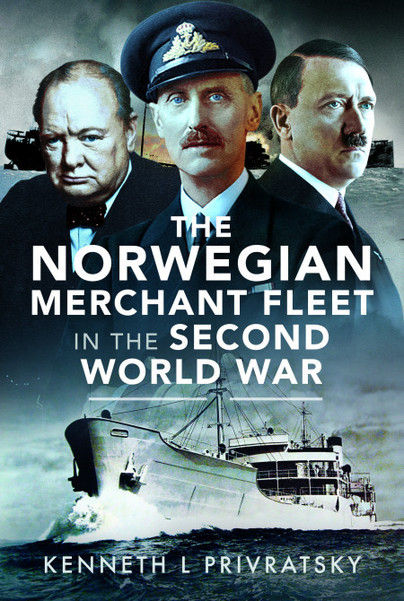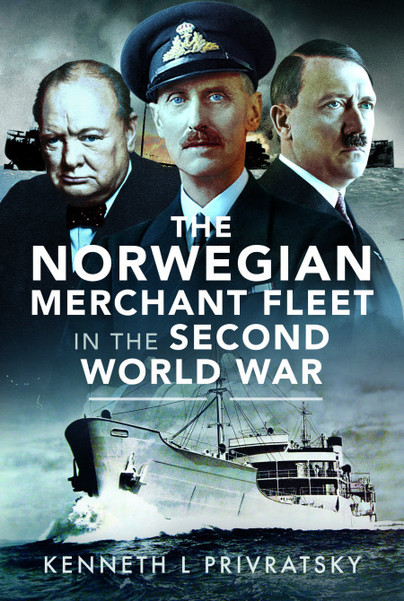Author guest post: Kenneth L Privratsky
What inspired me to write The Norwegian Merchant Fleet in the Second World War
by Kenneth L Privratsky, Major General, US Army (Retired)
Norwegian heritage goes back eight centuries in my family. My mother was very proud to be one hundred per cent Norwegian, born of immigrant parents arriving in America in the early 1900s from Kristiansund. She raised me to share her love for Norway. I indeed take pride in being half Norwegian and was especially honored when, in early 2016, one of my cousins there invited me to participate in National Day festivities in Kristiansund on 17 May. That is the day each year when Norwegians celebrate the signing of their country’s constitution in 1814. Specifically, I was asked to march in a parade with him and others that morning, to provide remarks when the parade concluded at a memorial for fallen seafarers, and then to lay a wreath in their memory. That experience eventually became the genesis for this book.
I thought I knew quite a lot about the history of Norway and its sagas from the sea extending back to the time of the Vikings. My many years in the military and study of warfare left me feeling confident that I had gained a pretty good understanding of the Second World War as well, to include Germany’s invasion of Norway in 1940 and the eventual bombing of Kristiansund. As I researched remarks for that day, however, I came to discover how much I did not know about the invasion and especially the significant support that Norway provided the Allies during the war despite losing their country to the Germans. I searched for books about Norway’s seafarers in preparation for my remarks. The only one in English I found was by Nora Slocum published in 1969 titled Saga of the Sea: Norway’s Merchant Marine in World War II. That seemed especially relevant, and I bought a used copy on the internet. I discovered it was a translation with two sources: a book by Lisa Lindbaek titled Tusen Norske Skip or ‘A Thousand Norwegian Ships’ published in 1943 and a manuscript of her other material. Lindbaek, a Norwegian, had been traveling by ship to the United States in the early 1940s when she became stranded in Africa for some unknown reason. While there, she encountered Norwegian seafarers who had been interned. When she eventually reached the States, she gained employment as a reporter for the Norwegian-language paper Nordisk Tidende in Brooklyn and in that position met other seafarers. From her conversations with them, Lindbaek compiled notes, which later formed the chapters of her book. She referred to it as an anthology of their stories from the seven seas. The gentleman in New York who wrote the foreword for her book was Øivind Lorentzen, the Director of Shipping in the United States for Nortraship, a Norwegian Government organization established in London the same month Germany invaded Norway. It managed the largest merchant fleet the world had ever seen. King Haakon VII personally appointed Lorentzen to head the organization as he and others in the Government were fleeing across central Norway from the Germans. Lorentzen proved to be a controversial choice. I had never heard of him or the so-called Nortraship organization he led.
What would compel a woman like Lindbaek to publish a book like this at the height of the war? The answer, I think, is simple. She grasped the enormous contributions that Norwegian shipping and seafarers were making at the time. She likely knew what most of us still do not know, that the small country of Norway, then occupied by Germans, had become key to the Allied war effort. She wrote as Britain was struggling to protect its ships from German submarines and its homeland from bombers. Ship losses had caused imports to plummet, leading to more and more rationing. Her book came out a year after the United States entered the war as its shipyards were beginning to make up for losses at sea. Simply put, the merchant fleet from Norway had been helping to keep the Allies in the war up until then. Lindbaek saw that. Norway claimed the fourth largest fleet in the world on the eve of the Second World War, and its ships were by far the most modern. A thousand Norwegian ships eventually supported the Allies, starting in 1939 and continuing past the end of the war. There would have been a couple hundred more had Germany not captured them when it invaded Norway. Half of the Norwegian ships would sink, however, and over 4,000 seamen and women would lose their lives.
I spoke to these losses at the Seafarers’ Memorial in Kristiansund before laying a wreath at the monument in their memory. I told the audience that morning that the Battle of Britain could have been quite different had it not been for those ships and seafarers. It is hard to think otherwise. After all, at that time, Norwegian tankers were hauling close to half the oil Britain needed. There would have been considerably less fuel for Spitfires to burn without the support of those tankers in the year leading up to that fight. The British people would have faced even stricter rationing without the cargo on other Norwegian ships too. President Roosevelt, Prime Minister Churchill, and officials on both sides of the Atlantic recognized the value of this help. What surprised me that morning in Kristiansund, however, was discovering how little even the Norwegians around me knew of their country’s enormous contributions to the Allied victory. Since then, I have realized from many other conversations that those of us outside of Norway know even less.
I would like to think my book helps complete the story Lindbaek and others started. Although much has been written about Germany’s invasion of Norway and even merchant shipping in the Second World War, there remains very little printed in English about the contributions of Norway’s ships and the organization called The Norwegian Shipping and Trade Mission, nicknamed Nortraship, that was formed to manage them. My intent in The Norwegian Merchant Fleet in the Second World War is to share this little-known story so that it does not simply fade away. I try my best to tell it in the context of the war itself. What happened is not without controversy. Some have accused Norwegian shipowners of profiteering during wars in the Twentieth Century. There is certainly a basis for such opinions. There can be little doubt, though, that those aboard Norwegian ships remained far removed from any profits. Norwegian seafarers who survived those perilous years at sea returned home to confront a war of a different nature. That part of the saga might come as a surprise to readers and provides reference for all of us when war heroes eventually come home.

Order your copy of The Norwegian Merchant Fleet in the Second World War here.
Follow the author’s Facebook page.


